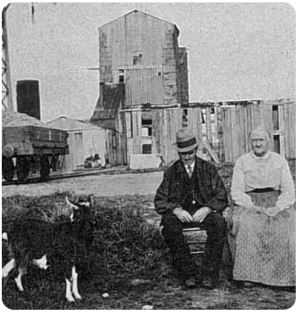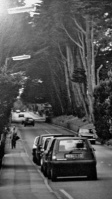History
La Moye [1] comes from the Jèrriais term mouaie which means 'stony heap', matching the view of the headland from the sea.
Vingtaine de la Moye encompasses the south-west corner of the island and included within its boundaries are La Corbière, to the west; St Brelade's Church and the Fishermen's Chapel on the eastern boundary. The northern boundary runs from just north of La Pulente, dissecting Route Orange where La Moye School is located, and heading south-east towards the bottom of La Marquanderie.
Boundaries
La Moye, it appears, was very much its own community, separated from St Peter and St Ouen by the natural barrier of the sand dunes to the north and the rocky headland to the east. [2]
The 1795 Richmond Map shows a number of properties in the area, including La Moye Manor, La Moie Villa, Maison Gruchy, Oak Lane Farm, The Poplars and La Sergenté.
The construction of Route Orange in the early 1820s [3] provided an easier route to and from the rest of the parish and from there to the rest of theisland. The road is clearly marked about a quarter of a century later on the 1849 Godfray map.
Boomer family
1902 saw the opening of La Moye Primary School and the beginnings of La Moye Golf Club, both important elements of the community. They have a shared history because George Boomer, the first headmaster of La Moye School, was responsible for the founding of the golf club.
Born in St Helier in 1857, George William Boomer [4] trained to be a teacher and after some time spent teaching in London, moved back to Jersey with his wife, Emma, and their sons, to teach at Grouville Central School. It was there that he would teach (in both an academic and sporting sense) future Open and US Open Champion golfers Harry Vardon and Ted Ray. Both of his sons, Percy and Aubrey, would also go on to be professional golfers, Aubrey playing in the 1927 Ryder Cup.
Jersey Archive holds a copy of La Moye School's log book, which makes for fascinating reading and gives an insight into some of the challenges that faced this country school and the wider La Moye community.
Virtually every other page contains a comment about the poor attendance levels of the children, with both the weather and agricultural work affecting whether they made it for lessons. George Boomer summed this up best in an entry for February 1904:
- "The week has commenced with beautiful weather and, as a number of farmers have seized the opportunity of commencing to plant potatoes, the school attendance, especially in the first class, has commenced to fall off, owing to the children being required to help in this very important business. All through the winter the children have been kept away by the wet and stormy weather and now that a spell of find weather has set in, work in the fields deprives the school of a third of its scholars. Holidays will now have to be given, as the planting season will last a month, and it is of no use trying to work a half-empty school.'
Occupation
As for many other schools in Jersey, the German Occupation presented many challenges for pupils and teachers. Mrs Bessie Godfray had been appointed headmistress in 1927 and she was in charge at the start of the Occupation. She wrote of the confusion in early July 1940 over exactly which families had evacuated or had moved to St Helier to find work.
She had to request a transfer to a different school in September that year, because the Germans had by then forbidden the use of private vehicles and closed some roads, meaning that the distance from her home at Les Jardins, St Ouen, was too far from La Moye school on her bicycle. Reginald Charles Foote took over.
During the latter part of 1941 German officers visited the school with the Constable of St Brelade to discuss the possible requisition of the building. Headmaster Foote wrote that they had been warned that if the building was requisitioned they would have to vacate within 48 hours, so he asked the teachers to bundle up the school books in readiness.
On 29 January 1942 the school was closed and all stock and furniture moved to L'Harmonie, opposite the Poplars, where the school reopened on 23 February.
Deportation
In late September 1942 orders for the deportation of all English-born men and their families were received and, even though he might have claimed exemption due to his profession, Mr Foote wrote on 28 September that 'I consider it my duty to travel with other English families. I expect to be deported tomorrow and am therefore closing school until Wednesday'.
The following day Reginald Foote, his wife Kathleen, and their daughter Elizabeth, were all transported from Jersey, eventually arriving at Dorsten Transit Internment Camp, before their transfer to Biberach Internment Camp in southern Germany.
While interned in both camps Mr Foote resumed teaching and there is a cartoon of him as 'headmaster', drawn by fellow Biberach internee Arscott Dickinson, a former States librarian, in the Jersey Archive collection.
Golf
George Boomer will be better remembered for his connection with La Moye Golf Club, a short distance from the school. In March 1904, in his role as secretary of the club, together with its president, Herbert Middleton, they leased land from Albert Le Gallais, of La Moye Manor, on which a redesigned course was opened the following year.
Mr Boomer's old pupil Harry Vardon came to play a match over the La Moye links later in the year and a newspaper reported that a special train had been put on from town,over 200 spectators arriving to watch. Interviewed shortly afterwards by the Jersey Times, Vardon remarked:'From a purely golfing point of view, La Moye course was better than Grouville ... a good test of golf; and it was a treat to play well upon it, as good strokes were rewarded by the result'.
The first clubhouse was built in 1908 and in the 1911 census Emma Boomer was recorded as the club's stewardess.
In the early evening of 4 February 1932 disaster struck when fire broke out in the clubhouse, destroying the main portion of the building and causing damage which was estimated at over £2,000. The ladies' section of the clubhouse, which had been a recent addition, survived relatively intact, but a Jersey Weekly Post reporter painted a vivid picture of the aftermath: 'Disconsolate men golfers stood in knots discussing the blaze and the loss of their clubs, and in many cases other possessions as well'.
La Moye Quarry

La Moye is a wide area stretching across the south-west corner of Jersey. It is also a Vingtaine of the parish of Saint Brelade.
In the north is La Moye Golf Club, overlooking the Blanches Banques sand dunes and St Ouen's Bay, and in the south is the rocky coastline from La Corbière lighthouse eastwards towards Beauport. In this area can be found the Desalination Plant of the Jersey New Waterworks Company, and the island's prison.
- Coast: La Moye, one of the stops on our coastal tour of Jersey NEW
- La Moye, St Brelade, a very old property
- La Moye Golf Club
- La Moye School
Notes and references
- ↑ The spelling La Moie is also correct
- ↑ La Moye is not close to St Peter or St Ouen. It's landward border is all with The Vingtaine du Quennevais, of St Brelade. St Peter is beyond this vingtaine and St Ouen is beyond St Peter, further north
- ↑ Named for the Constable of St Brelade at the time, John Orange
- ↑ Family tree
Gallery
Click on any image to see a full-size version
Rocks at La Moye. There are a number of caves in this area, including Smuggler's Cave and Pirate's Cave


















